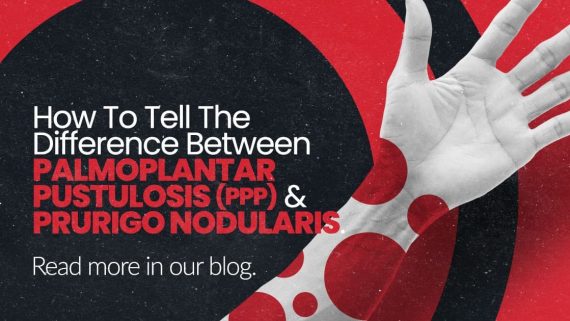Palmoplantar pustulosis (PPP) and prurigo nodularis (PN) are a pair of tongue-twisting skin conditions we’re conducting clinical trials for. Though neither is very common, you can easily confuse the two because of their similarities. Here’s how to tell the difference between palmoplantar pustulosis and prurigo nodularis.
Symptoms of PPP and PN
PPP is a rare form of psoriasis where tiny blisters develop on the palms of hands and soles of feet. As the blisters dry up, they can turn brown and scaly, and deep cracks can form. PPP can be itchy and painful and cause a burning sensation in the hands and feet. As a result, patients may have difficulty walking comfortably or using their hands without pain.

PN affects the skin by causing hard, itchy bumps to form on the arms, legs, upper back, and abdomen. The itching is usually very intense, and patients often scratch themselves to the point of bleeding or pain. Loss of sleep, scarring, and changes to the skin’s surface are some of the most common impacts of PN.

Potential Causes
So far, we know that both conditions involve bumps that can be itchy and painful. On the other hand, they differ in:
- Location on the body
- Type of bump (blister vs. hard bump)
- Itch severity
- Ways they impact patients’ lives
Researchers are still working to identify the exact cause of both conditions better, though there are some potential factors for PPP include:
- An effect of nicotine on the sweat glands of the hands and feet since most patients are current or former smokers
- Family history
- Medication side effects
- Infections
For PN, researchers believe the “itch-scratch-itch cycle” is a significant player in developing this condition. PN begins with itchy skin that causes the uncontrollable urge to scratch and rub it. After about six weeks, the hard bumps form in the areas you’ve been scratching and rubbing. Many people who develop PN already have another condition that makes their skin extremely itchy, like eczema. Individuals with this condition also have thicker nerve cells in the skin, which may mean the signals letting the brain know the skin is itchy are more substantial than someone without PN.
Treatment
Treating both conditions involves a combination of therapies that you apply to the skin, take by mouth, or inject. These aim to:
- Remove or lessen the appearance of bumps
- Reduce the itchiness
- Suppress the overactive response from the immune system
- Control inflammation
In addition, habit reversal therapy is another part of treating PN that helps reduce the frequency of scratching. This technique uses awareness training and behavior modification therapy to create alternatives to scratching the skin.
ActivMed Practices & Research is looking for individuals with PPP and PN to join enrolling research studies evaluating potential new care options. To see if you may qualify, visit the Portsmouth, NH webpage for our PPP studies or visit the Beverly, MA webpage for our PN studies today!
Sources:
https://www.aad.org/public/diseases/a-z/prurigo-nodularis-treatment
https://rarediseases.info.nih.gov/diseases/7480/prurigo-nodularis

